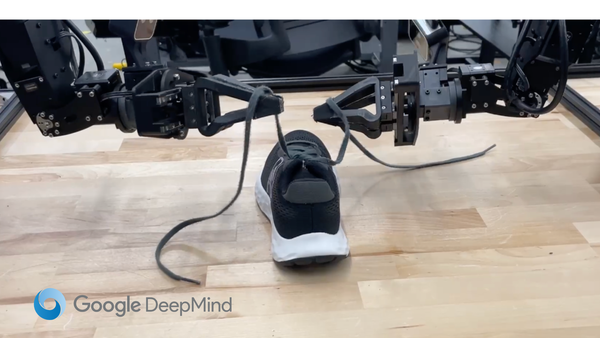Humanoid Brain Made From Human Cells, Robots Are Manufacturing Cars, and More
Explore groundbreaking advancements in humanoid robotics, from brain-on-a-chip technology to innovative industrial automation and AI-driven enhancements in factory operations. Discover how these developments are shaping the future of robotics.

For the last couple of weeks, I spent a lot of time working on profiles for Apptronik and Apollo (below). I'm also in the process of getting my YouTube channel and podcast up and running for Tekmorrow.
I'll let you know when everything is kicked off. In the meantime, I captured five of the biggest news stories below. The first one freaks me out, but I'm sure this won't be the last time I get the heebeegeebees from humanoid technology.
Let's dive in...
New Humanoid Robot Brain Made From Human Cells
Chinese researchers have created a robot powered by a brain made from human stem cells, marking a significant advancement in brain-computer interface technology.
WHAT YOU NEED TO KNOW
- Stem Cell Brain: Researchers at Tianjin University have developed a "brain-on-a-chip" using human stem cells to control a robot.
- Neural Interface Chip: The stem cell brain is attached to a neural interface chip, allowing the robot to perform various tasks autonomously.
- Open-Source System: The design is the world's first open-source brain-on-chip system, potentially leading to more brain-like computing developments.
WHY YOU SHOULD CARE
- Technological Innovation: This breakthrough showcases the potential of brain-computer interfaces and brain-on-chip systems to revolutionize robotics and computing.
- Advancements in Robotics: Integrating a stem cell brain enables the robot to perform complex tasks autonomously, pushing the boundaries of what robots can achieve.
- Future Implications: The success of this project could lead to further advancements in hybrid human-robot intelligence, enhancing robots' capabilities and applications in various fields.
Source: BGR
Ginormous Humanoid Robot To Maintain Train Lines
West Japan Railway has introduced a 12-meter-high humanoid robot designed for maintaining train lines. The robot is equipped with large arms that can handle various tools for tasks like painting and trimming tree branches.
WHAT YOU NEED TO KNOW
- Deployment and Design: The 12-meter humanoid robot, resembling a Wall-E-like figure, is mounted on a truck and can drive on rails to perform maintenance tasks.
- Operational Capabilities: The robot's operator controls it remotely, using cameras to "see" through its eyes. Its arms can handle attachments for carrying heavy objects, painting, and trimming branches.
- Strategic Purpose: This robot aims to address worker shortages in Japan and reduce accidents by performing high-risk tasks such as working at heights and near electrical cables.

WHY YOU SHOULD CARE
- Operational Efficiency and Safety: The robot enhances safety by taking over dangerous tasks, reducing the risk of accidents like falls and electric shocks, and improving maintenance efficiency.
- Technological Innovation: Integrating remote-operated, versatile humanoid robots represents a significant advancement in industrial maintenance technology, showcasing how robotics can transform infrastructure management.
- Addressing Labor Shortages: As Japan faces an aging population and labor shortages, using robots for maintenance provides a practical solution, ensuring continuous operation and safety in the railway industry.
Source: The Guardian
Researchers Are Developing A New Process For Training Humanoid Robots
Stanford researchers are developing ways to train robots using audio, aiming to make them more adaptable and useful in environments with limited visibility.
WHAT YOU NEED TO KNOW
- Training with Audio: Stanford's Robotics and Embodied AI Lab has developed training algorithms that help robots gather clues from audio signals to perform tasks more effectively.
- Improved Success Rates: In tests, robots trained with audio significantly outperformed those trained only with vision, achieving a success rate of 94% in identifying dice in a cup compared to 27% using vision alone.
- Future Applications: Audio training can enhance robots' ability to perform tasks in homes and other environments where sound provides crucial information, such as knowing if an eraser is properly contacting a whiteboard.

WHY YOU SHOULD CARE
- Enhanced Adaptability: By using audio, robots can adapt to environments where visibility is limited, expanding their utility beyond traditional settings.
- Increased Efficiency: Training robots with audio data can significantly improve their accuracy and effectiveness in everyday tasks, leading to better performance in practical applications.
- Technological Innovation: This research represents a significant step towards integrating audio as an essential sensory modality for robots, potentially transforming how they learn and operate in various settings.
Source: MIT Technology Review
Figure's Humanoid Robots Are Assembling BMWs
Figure's humanoid robot, Figure 01, is now showcasing its capabilities in car assembly at BMW's Spartanburg, South Carolina, facility.
WHAT YOU NEED TO KNOW
- Deployment Agreement: Figure signed its first commercial agreement with BMW to deploy its 01 humanoid robot in its production facility.
- Technological Capabilities: The robot operates autonomously using neural networks that map pixels directly to actions, enabling precise object manipulation and assembly tasks.
- Future Integration: The 01 robot will undergo a 12 to 24-month training period before being fully integrated into BMW's assembly line.
Figure + BMW Group's Spartanburg Plant
— Figure (@Figure_robot) July 1, 2024
→ Fully autonomous
→ AI-driven vision model
→ Neural Networks for all grasps pic.twitter.com/btBCi2gk7x
WHY YOU SHOULD CARE
- Operational Efficiency: Deploying autonomous robots like Figure 01 can significantly enhance manufacturing efficiency by performing repetitive and hazardous tasks.
- Technological Innovation: Leveraging advanced neural networks and vision-language models for robot operations showcases AI's potential to transform industrial processes.
- Workforce Automation: As labor supply growth stagnates, integrating humanoid robots can address workforce challenges and increase productivity, positioning companies at the forefront of industrial automation.
Source: Interesting Engineering
Sanctuary AI Reaches $140 Million in Funding
Sanctuary AI has secured over $140 million in funding to develop robots with humanlike intelligence, backed by BDC Capital and British Columbia's InBC fund.
WHAT YOU NEED TO KNOW
- Significant Funding: Sanctuary AI has received a new investment, bringing its total funding to over $140 million. The company aims to create general-purpose robots with humanlike intelligence.
- Strategic Vision: Co-founder Olivia Norton emphasizes the potential of AI in the physical world to transform work and productivity, especially given demographic shifts like aging populations and declining birth rates.
- Collaborative Potential: Integrating AI and robotics is seen as complementary to human work, enhancing efficiency and flexibility in various sectors, particularly in warehouse and fulfillment operations.

WHY YOU SHOULD CARE
- Technological Advancement: The significant investment underscores the growing belief in AI's potential to revolutionize physical tasks and enhance capabilities in various industries.
- Economic Impact: As populations age and birth rates decline, the need for intelligent robots to maintain productivity and support the workforce becomes increasingly critical, positioning Sanctuary AI at the forefront of this transition.
- Future of Work: The collaborative use of AI-powered robots alongside human workers can bridge labor gaps and meet rising demands, reshaping tasks and enhancing overall efficiency and productivity.
Source: PYMNTS



